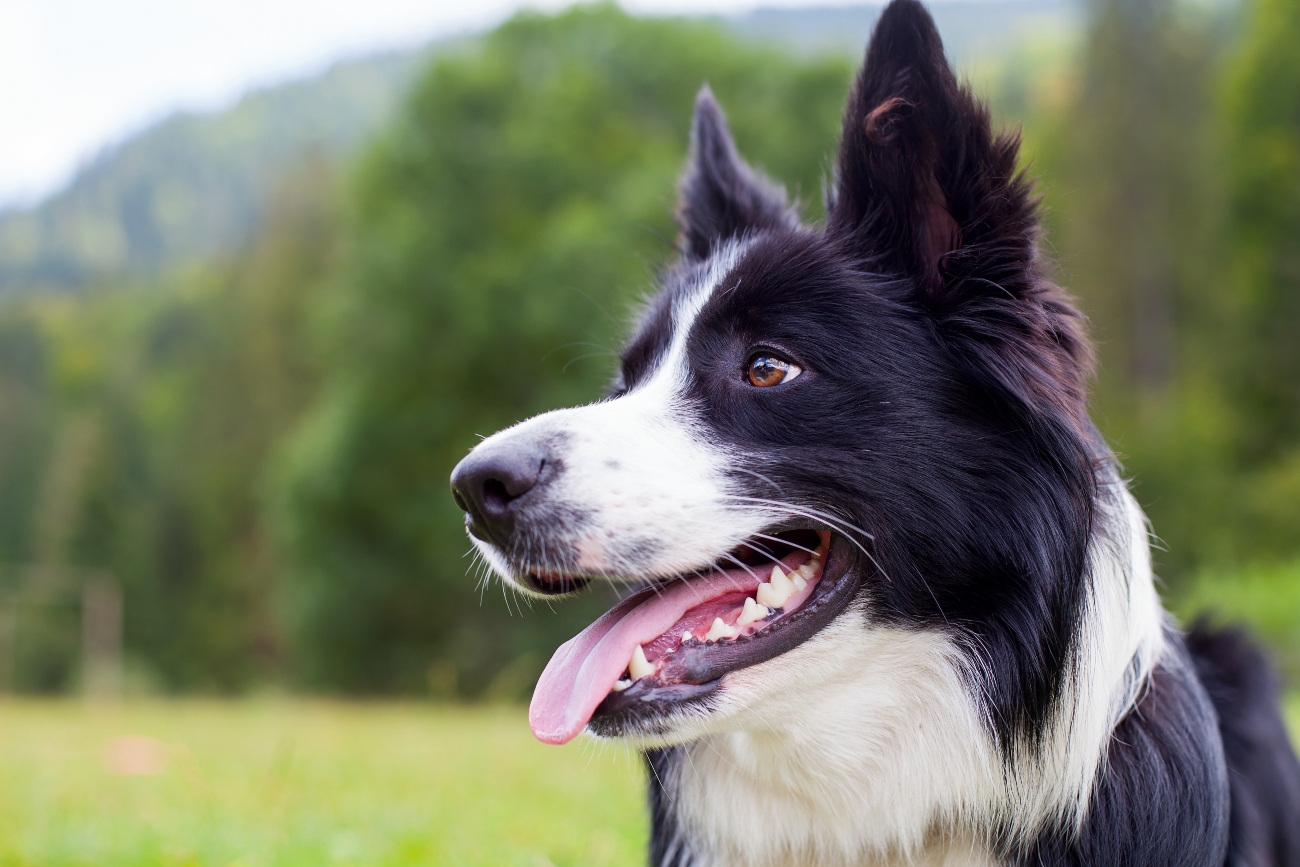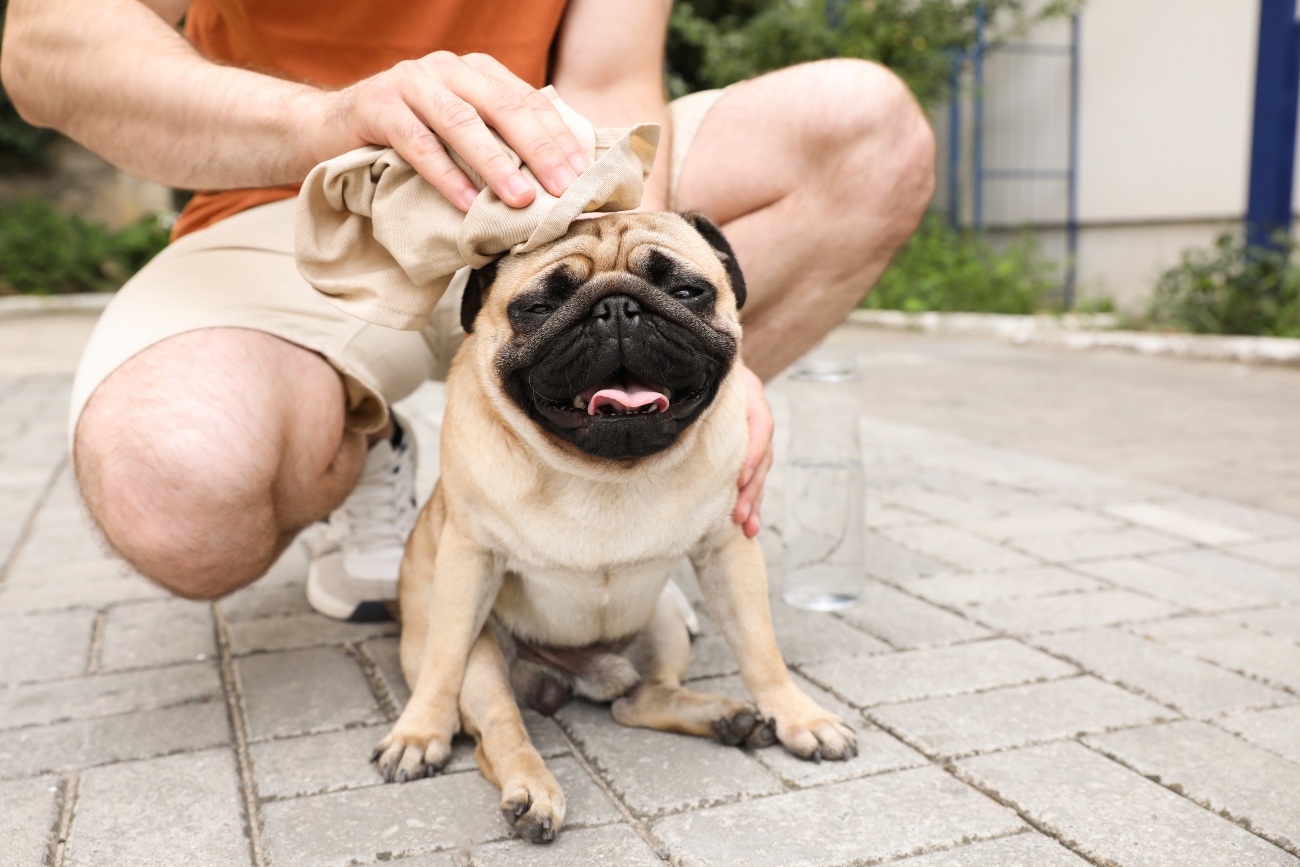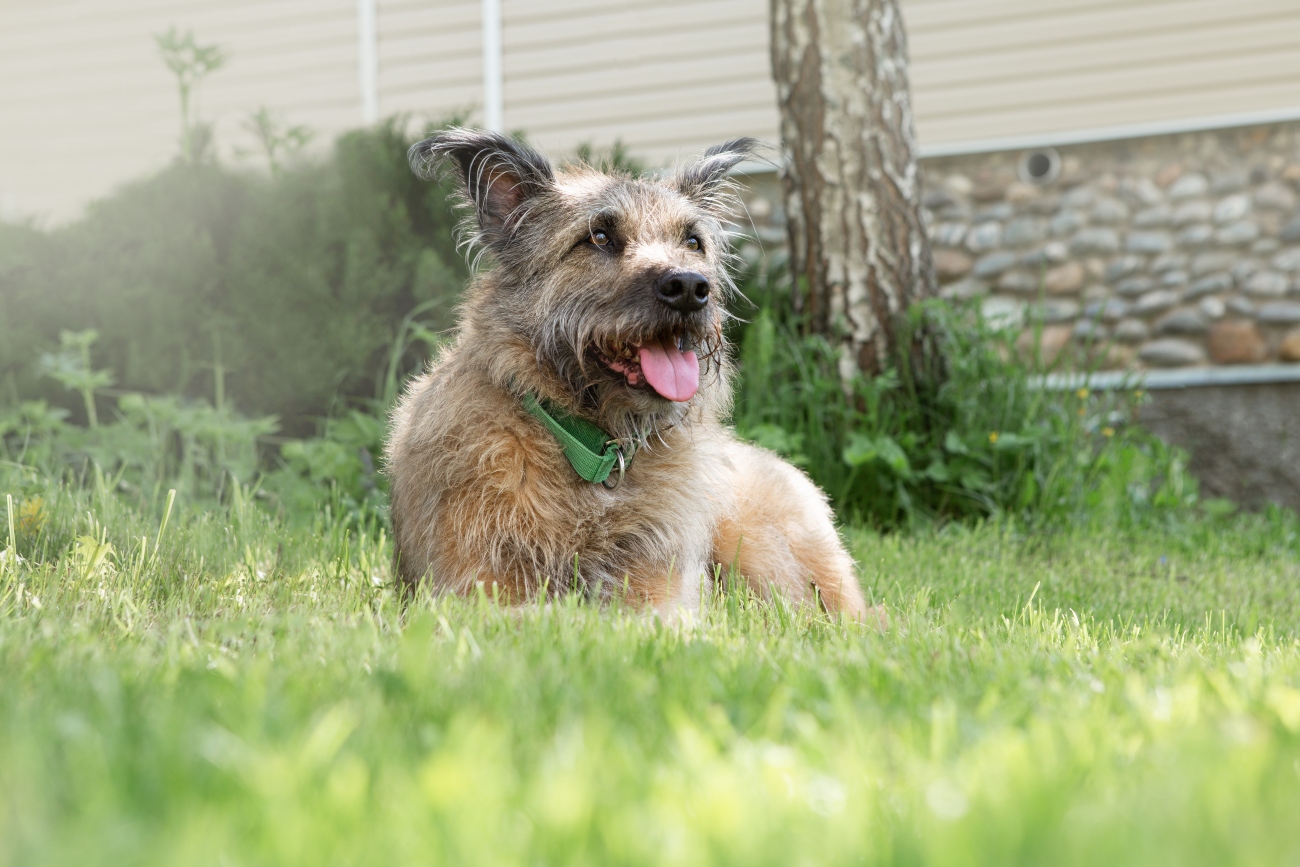
Heavy panting in older dogs
19th August, 2022
While it’s completely natural for a dog to pant, when your older dog won't stop panting excessively it can be a worry. To get to know the common causes for panting and how to help your older dog, read this handy guide from the caring team at Petwise.
If you’re still worried, then your vet will obviously be your first port of call. But it’s also useful to remember that policyholders who have old dog pet insurance arranged through Petwise can always call our 24-Hour Vet Helpline for advice. Staffed by veterinary professionals, it’s a quick and easy way to put your mind at rest.
Why do dogs pant?
Panting is a perfectly normal behaviour in happy and active dogs and is used to help keep them cool. Unlike their human family members, sweating plays only a very small part in controlling our furry friends’ body temperature. Instead, dogs pant to evaporate moisture from the tongues, mouth, nasal passages and upper respiratory and keep their bodies from overheating.
So, in many cases, noticing your dog is panting just shows they’re excited, hot or just taking a break from exercising. If you’re concerned your older dog is panting because they’re too hot and you want to help cool them down, then follow these top tips from Battersea. The shelter’s got plenty of invaluable advice on keeping dogs cool in the summer.
Should I be worried about my older dog panting? Common causes and treatments
As dogs age, they can become more prone to health problems. A common symptom of many health problems is excessive panting. So, it’s important to keep a watchful eye on your dog’s panting behaviour so you’re ready to act if something changes.
The 10 signs there could be something more serious worth investigating are:
- Your older dog is panting and restless.
- Your older dog has been panting non-stop for a long time.
- It is abnormal panting.
- They start panting suddenly for no obvious reason.
- The panting is accompanied by shaking.
- They seem in discomfort or in pain.
- They’re panting at a time that seems unusual.
- Their panting sounds louder or harsher than usual.
- Your dog seems to be struggling to breathe.
- Their tongue and gums look blue, purple or white. This could be due to a lack of oxygen.
You always need to be extra vigilant when it comes to an older dog panting constantly. Even though it can be normal dog behaviour, sometimes it isn’t, and may require medical attention.
If you’re at all worried about how you would care for your beloved old-timer if they became ill then give our friendly UK-based team a call. They’ll take you through all you need to know when it comes to arranging old dog pet insurance.
There are many health conditions which list abnormal, heavy or excessive panting as a symptom.
We’ve listed some of the more common ones below, along with what to look out for, their potential seriousness, and how you can help.
Heat stroke

When the weather gets warmer a dog’s body temperature can rise to dangerous levels. Heat stroke is a potentially life-threatening condition that could kill your pet in as little as 15-minutes.
Keeping your dog out of the sun and well-hydrated are the best ways to stop heat stroke from happening in the first place.
And never leave your dog in a parked car during warm weather, even on a cloudy day this could spell death for your faithful friend.
What to look out for:
As well as faster, heavier panting, if your dog is suffering from heatstroke then you might notice the following:
- Excessive drooling
- Abnormal thirst
- Vomiting or diarrhoea
- Lethargy
- Wobbly and uncoordinated movements
- Glazed eyes
- Rapid pulse
- Seizures and collapse
- Unexplained bruising on the gums or under the skin
If you own a breed like a pug or bulldog, then be aware their flat faces mean they don’t pant as efficiently as other canines.
This makes them more susceptible to overheating than other dogs.
Is it serious?
Even with the very best care, a dog that develops heatstroke can be at risk of life-threatening problems such as swelling of the brain, kidney failure, and intestinal bleeding.
Indeed, the British Veterinary Association found that one in seven dogs diagnosed with a heat-related illness will go on to die.
How to treat:
If you think your old dog is suffering from heatstroke then you need to act quickly.
- Move them to a shaded or cooler area.
- Pour cool (not cold) water over them.
- Place wet towels on them or put them in the breeze of a fan.
- Allow them to sip small amounts of cool water.
- Never cool them so much that they start to shiver.
- Once they’ve cooled down, get them to the nearest vet as a matter of urgency.
For the best chance of survival, you must lower their body temperature. But it's important to do this gradually.
The RSPCA advises that if ever you see a dog in a parked car displaying any signs of heatstroke, then dial 999 immediately.
Poisoning and allergic reaction
Excessive panting can be a sign your dog has consumed something they shouldn’t have or has suffered an allergic reaction.
These are some of the most common emergencies that veterinary professionals will come across.
What to look out for:
Depending on what substance they have been exposed to common symptoms include:
- Diarrhoea and/or vomiting
- Shaking, staggering and/or seizures
- Breathing difficulties, including coughing or sneezing
- Skin irritation/scratching
- Loss of appetite
- Increased drinking and urination
Is it serious?
As long as they’re treated promptly, not many substances will cause a fatal reaction. That’s why it’s so important to get help from a qualified veterinary professional immediately.
How to treat:
If you suspect your senior dog has been poisoned then call your vet immediately or call the 24-hour Animal Poison Line.
Be sure to note down as much information as you can about the suspected poison, how they came to be poisoned and how much you think they have consumed.
If you see something poisonous on your dog’s fur or paws, try to prevent them from licking it off. Try to wash them with warm water and mild shampoo, then wrap them up in a towel to dry them off and regulate their temperature.
Never make your dog vomit, unless your vet tells you to.
As with many things in life, prevention is often better than cure.
The following are potentially harmful substances that you need to keep a careful eye on around your house and garden.
- Human medication
- Pest killers
- Chocolate
- Grapes, sultanas, currants and raisins
- Cleaning products including bleach, laundry detergents and disinfectants.
- Antifreeze containing ethylene glycol
- Lilies, plants and other flowers
- Onions, shallots, garlic or spring onion
Be aware, pet care specialist Purina warns that if you recently started giving your dog new medication it might have caused an allergic reaction.
Speak to your vet if you’re worried.
Whatever happens, if your dog is having difficulty breathing and you think they’ve been poisoned or are having an allergic reaction, then call for help immediately. When an emergency happens you’ll be glad you invested in old dog pet insurance from Petwise.
Meaning you can focus on helping your trusty four-legged friend rather than worrying about the potential vet bill.
Heart failure
Dog and human hearts are nearly identical in structure and both play a vital part in pumping oxygen-rich blood and nutrients around the body. Unfortunately, as a dog ages their heart will inevitably deteriorate and become less efficient at doing this.
What to look out for:
As the respiratory rate rises to compensate for the lack of oxygen being circulated, you’ll notice heavy breathing and panting. You might also notice low energy, coughing, exercise intolerance, restlessness during sleep, rapid weight loss, swollen abdomen, and even collapse.
Your vet will need to listen to your dog’s heart and may recommend other procedures to help determine the exact problem.
Is it serious?
Although heart disease is serious, most types can be treated with medicines, careful monitoring and lifestyle changes. While most types of heart disease will worsen as the dog gets older, there is a lot you can do to maintain their quality of life.
How to treat:
Any problems with your dog’s heart will need to be assessed and treated with guidance from trained veterinary professionals.
Always follow their advice and keep up with any prescribed medications.
At home you’ll want to review your old dog’s diet and any exercise requirements. To help keep your trusty canine companion happy and healthy, old dog insurance arranged through Petwise includes a senior food contribution.
We’ve got lots more interesting information on heart problems in dogs elsewhere on our site.
Brachycephalic Obstructive Airway Syndrome (BOAS)
As we mentioned earlier, one of the most common problems suffered by dogs with flat faces such as pugs and French bulldogs is an inability to breathe normally. This condition is called Brachycephalic Obstructive Airway Syndrome (BOAS) and is particularly noticeable after exercise or when eating.
What to look out for:
Affected dogs will be noisy breathers and most will snort when excited and snore when relaxed or asleep. They might also tire more easily, and may even collapse or faint after exercise.
Other signs include coughing, gagging, retching, and vomiting. Symptoms can often be worse in hot or humid weather.
Is it serious?
Over time the syndrome has been linked to harmful changes in the lungs and gastrointestinal tract.
It can lead to inflammation of other structures in the airways and can put increased strain on the heart.
How to treat:
Obesity can worsen the signs of the syndrome, so weight loss may be advised. Mild signs are usually managed by controlling exercise levels and avoiding hot and humid conditions and stress.
Surgery has been used successfully in many cases.
Respiratory illness
There are many disorders of the respiratory system that can lead to breathing difficulties and panting in older dogs. Some of the most common include laryngeal paralysis, pyothorax, lung tumours, bronchitis and pneumonia.
What to look out for:
As well as panting, respiratory illnesses can also cause coughing, difficulty breathing, lethargy and a host of other symptoms depending on the cause.
Is it serious?
Any illness affecting the respiratory system is serious and needs to be treated as a matter of urgency.
Such conditions will worsen over time if not treated promptly.
How to treat:
The precise treatment will depend on the illness. If you suspect your old dog’s panting could be related to respiratory problems, then you must speak to your vet to get the appropriate treatment plan in place.
Anaemia
When there’s a drop in the number of red blood cells anaemia can occur. And because these cells transport oxygen around the body, your dog may pant more to compensate for the lack of oxygen.
What to look out for:
The signs and symptoms of anaemia in dogs include:
- Pale gums, eyes or ears
- Black faeces
- Fast pulse and rapid breathing
- Vomiting
- Lethargy
- Loss of appetite or weight loss
- Swelling in the face or jaw
Is it serious?
Anaemia often indicates another disease, some of which can be fatal, so, it should always be taken seriously.
How to treat:
There are many types and causes of anaemia, so treatment can vary.
Your vet will be best placed to recommend the correct treatment.
Cushing’s disease
Also known as hyperadrenocorticism, this disease tends to be more common in middle-aged, small breed dogs such as Poodles, Terriers and Dachshunds.
It develops when a dog’s overactive adrenal glands produce high levels of a steroid called cortisol. This can be due to a brain tumour or an adrenal gland tumour.
What to look out for:
Symptoms include excessive panting and shaking, increased thirst and hunger, increased urination, hair loss on the sides and tail, dark skin patches, lethargy, muscle loss and a swollen stomach.
Is it serious?
While Cushing’s disease has no known cure, with appropriate treatment most dogs will lead a happy and normal life for many years.
How to treat:
Most cases of Cushing’s respond well to medication, which controls steroid production. However, always be careful to administer the correct dose. If too much is given then levels may drop too low and cause Addison’s disease (hypoadrenocorticism).
Surgery is sometimes used to remove the tumour in the adrenal gland or brain, but this has its own risks.
As an ongoing condition that needs lifelong medication, Cushing’s can become expensive to treat. It’s important to consider investing in old dog insurance as early as possible, before any signs of illness start. This will ensure you have all the support you need to care for your four-legged friend.
For even more information on Cushing’s disease read this helpful article from pet charity PDSA.
Anxiety and stress
Anxiety and stress aren’t just something that humans can struggle with; it can affect our canine friends, too.
As a responsible pet owner, it’s important that you know how to identify anxiety and stress in your dog and how you can help. An old dog who is panting and pacing at night could be in need of some emotional TLC.
What to look out for:
Battersea notes there are a number of common signs that show your pet pooch could be experiencing anxiety. Alongside excessive panting, these include:
- Tail tucked between their legs
- Licking lips
- Ears pinned back
- Raised paws
- Pacing around
- Yawning
They might also bark, shiver, hide, or destroy furniture.
There’s no one-size-fits-all approach and you might spot other behavioural changes, too.
Is it serious?
Unfortunately, stress and anxiety can be quite common in our dogs. And while the condition might not be life-threatening, it can severely affect your dog’s quality of life if it’s not managed carefully.
How to treat:
The first thing to do when considering how to treat an old dog who is panting from anxiety is to speak to your vet. They’ll be able to determine the cause of the anxiety and advise on what you can do to calm them.
There are many things you can do to help. From massage, gentle petting, and physical exercise to mental stimulation, consistent routines, and even a supplement such as Adaptil.
Sometimes you might need to try out a few different techniques to see which ones might work best for your family.
Pain
Unfortunately, while we often think we know exactly how our animal friends are feeling, this isn’t always the case. Particularly when they are in pain.
If your old dog is panting heavily but hasn’t been exercising, it could be they’re suffering in silence.
Panting or shallow breathing is a common sign that something is wrong and is often shown well before more obvious signs, such as limping or whining.
What to look out for:
There are many ways a dog can show they’re in pain. Some of these can include:
- Heavy panting or shallow breathing
- Aggressive behaviour
- Hiding
- Loss of appetite
- Sleeping more
- Growling and more vocalisation
- Excessive grooming
- Stiffness and limping
- Shaking and trembling
- Restlessness
However, some dogs might not show any signs of pain other than panting more.
Having old dog pet insurance in place can help you get a diagnosis as quickly as possible as you won’t put off going to the vets because of the cost.
Is it serious?
This will depend on the cause of the pain. But anything that affects your dog’s quality of life needs to be treated seriously.
How to treat:
Once your vet has worked out why your dog is in pain, they can prescribe suitable treatment and pain relief. This is particularly important for older dogs who might have other underlying conditions requiring medication.
Just as with humans, medication needs to be balanced carefully. Each dog will react differently to the type and dosage of medication.
Be sure to keep a close eye on your dog’s response to the medication. And contact your vet if you have any worries.
Call the specialists in old dog pet insurance

As your dog gets older, it’s not just excessive panting you need to worry about, they may have other health needs, too such older dog incontinence. That’s why there’s no upper age limit for taking out insurance cover with us.
After all, every dog we look after deserves the very best protection available.
Here at Petwise we can offer a choice of seven cover levels for old dog pet insurance to suit any budget or doggy needs. You’ll also find that dental cover is included on all policies*.
And when your dog comes to the end of their life, we also provide a bereavement helpline and farewell cover to help you through.
Finding old dog pet insurance is simple with Petwise – get a quote today.
*subject to annual dental check